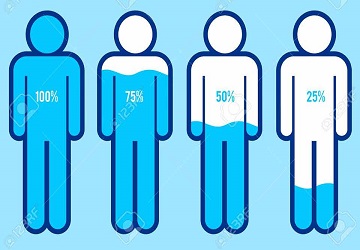Climate and Environment and Keeping Our Body Hydrated

Climate and Environment and Keeping Our Body Hydrated
How much of water is taken in on a daily basis varies with the environment we live in. The differences are not very pronounced unless the climatic condition is extreme. Water requirements in individuals are affected by the environment they work and live in. This is the reason for extra caution when a change in environment or climate takes place. Temperature (both heat and cold), higher altitudes, levels of humidity and even our clothing affect the water levels in our bodies. The environment that we are in usually dictates the amount of water lost.
Individual hydration needs
General recommendations are not valid for these environments. This is made even more difficult as each individual’s hydration will change according to personal factors in addition to the external conditions. Hydration status is directly linked to the available diet. For instance, mountain climbers facing high altitudes and scarcity of water need to take into account that they will require more water to counteract the constant threat of dehydration. It is evident that individuals working and living in extreme conditions should seek medical advice tailored to their individual needs. A good example is a miner working long shifts in very hot mine shafts. This also applies to people such as farmers, industrial workers, laborers and athletes who are required to exert higher levels of energy. People who are traveling to unused climates and engaging in extreme physical activities also should exercise caution regarding their levels of hydration.
Colder climates
In colder climate the loss of water happens differently. Since it is cold we might be forgiven for thinking that there is little or no perspiration. But the actual fact is that water is lost from sweat induced by heavy clothing and heightened respiration. Breathing in cold climates is more difficult and has a significant impact when exposed for long hours. Cold also induces more diuresis and to counteract this situation you have to be armed with sufficient water to replace the loss through urination.
Hot climates
It is accepted that more water is required in hotter climates as there is extreme evaporation. One aspect that people tend to overlook under the circumstance is the loss of salt from the body along with sweat. It should be replaced along with water for the proper body hydration balance to be maintained. If this is not regularized there is a potential problem of low potassium levels in the blood or hyponatraemia setting in. Sodium and potassium are important in regulating blood pressure and can have serious consequences if sodium and potassium levels are not restored. Thus, it is a good idea to always carry water or a beverage that contains sodium to keep up the hydration levels of the body.
Altitude
At high altitudes the air is drier and breathing becomes more labored. This situation leads to hyperventilation which in turn raises the amount of water lost due to respiration. Thinner air in higher altitudes causes the blood oxygen levels to decrease which induces hypoxia diuresis. This means a person at a high altitude will require more water in comparison to a person at sea level.
Extreme conditions demand better preparation with regard to the hydration needs of the body. It is best to have adequate water supplies within reach and in some cases beverages containing sodium can be of great help. Knowledge of hydration requirements will also make it easier to be well prepared. Symptoms of dehydration if known can be arrested immediately preventing possible death. Mental alertness, decision making and physical performance can be impaired making it dangerous to all around.
